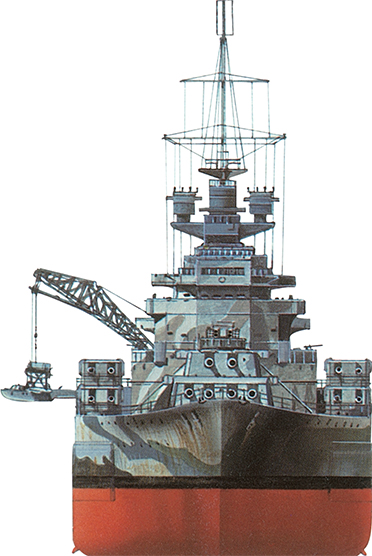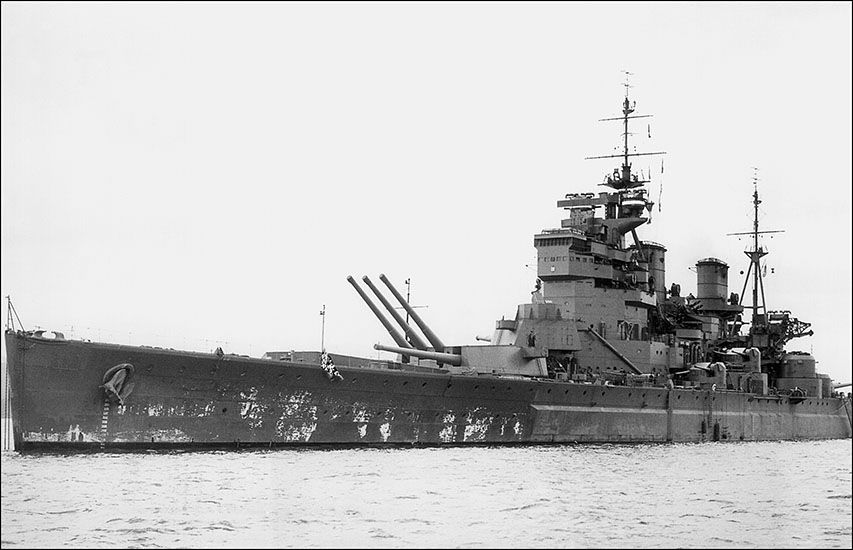 Prince of Wales (1941)
Prince of Wales (1941) Prince of Wales (1941)
Prince of Wales (1941)The second King George V class battleship, Prince of Wales, had a brief career: sunk off Malaya by aerial attack less than a year after commissioning, it gained the unfortunate distinction of being the first battleship sunk by aircraft on the open sea.
On 31 December the Washington Treaty ended and was not renewed. But plans had gone ahead in anticipation. In the USA and Japan, 408mm (16in) guns were being assembled for battleships. Britain had no blueprints for guns of this calibre, but did have a 356mm (14in) quick-firing gun of excellent quality, produced in the early 1930s, and the first of its type to be built in the form of a jacketed and hooped barrel.

The arrangement for accommodating aircraft, with a hangar each side of the forward funnel, and rails to a catapult set athwartships, begun with HMS Warspite in the mid-1930s. It was admired by the German Navy, which adapted it for the Bismarck class.
The King George V class, emerging from the 1936 building programme, was something of a compromise design. Based on a 31,751 tonne (35,000 ton) hull, it was to carry 12 356mm (14in) guns in three quadruple turrets. During design, to save weight for use elsewhere, the superfiring ‘B’ turret was reduced to a twin mounting. All five were laid down in 1937, Prince of Wales at Cammell Laird’s yard in Birkenhead in January.
Launched on 3 May 1939, Prince of Wales was completed in March 1941. The design was a balanced and handsome one, with the fore-funnel marginally taller than the after one; and the first British battleship to have quadruple main turrets. Apart from Rodney and Nelson, these were the first British battleships built since World War I, and they were seen as the new – and vitally necessary – backbone of the RN in a new conflict with Germany.

The advent of war prompted numerous alterations during completion, including extra ammunition, fuel capacity and radar antennae, increasing design displacement to 34,473 tonnes (38,000 tons) and deepening the draught from designed as 8.4m (27ft 8in) to 9.75m (32ft) with a corresponding reduction in freeboard.

Deck plan: of the five ships in the King George V class, only two, the lead vessel (up to 1943) and Prince of Wales carried aircraft, though the superstructure gap was intended for their deployment. It may also have helped in overall balancing of a hull 227m (745ft) long.
Secondary armament was 16 133mm (5.25in) guns, fully automatic and with a range of 20,570m (22,500yd), capable of long-range AA defence as well as knocking out destroyers. Original plans allowed for 32 40mm (1.6in) guns in eight-barrel mountings, and 16 four-barrelled heavy machine guns, but the machine guns were not installed on Prince of Wales. It was, however, fitted with eight UP smooth-bore multi-barrel AA batteries, ingenious but not very effective weapons intended to dangle small aerial mines from parachute wires.
Eight boilers in four compartments provided steam to four independent sets of geared Parsons turbines. The design speed could be forced up to 54km/h (29.2 knots) with an output of 93,212kW (125,000hp). The class carried approximately 10,886 tonnes (12,000 tons) of armour, with a high-level armoured deck resting on top of the side armour, with a maximum thickness of 152mm (6in) above the magazines. Protection was on the ‘all or nothing’ principle, and armour amounted to 40 per cent of design displacement. Careful design of the engine space made it possible to limit the length of the central armoured area to 136m (446ft) on a waterline length of 227m (744ft 9in). Torpedo bulges were not fitted, but the torpedo bulkhead was 51mm (2in) and effective torpedo protection space was 4.1m (13ft 4in).
Prince of Wales was still engaged on trials when ordered out on its first combat mission with HMS Hood against Bismarck and Prinz Eugen on 24 May 1941. An early hit knocked out the gunnery control system and it suffered considerable damage, withdrawing from the battle after the sinking of Hood. In August 1941 it carried Winston Churchill to meet President Franklin D. Roosevelt at Argentia Bay, Newfoundland. In September it was with Force ‘H’ in the Mediterranean, and after a brief return to Britain was deployed to the Far East, arriving in Singapore on 27 November 1941.
Specification
Dimensions |
Length 227.1m (745ft 1in), Beam 31.4m (103ft 2in), Draught 10.5m (34ft 4in), Displacement 40,415 tonnes (44,550 tons) full load |
Propulsion |
8 Admiralty 3-drum boilers, 4 Parsons geared turbines developing 82,000kW (110,000hp) |
Armament |
10 360mm (14in) guns, 16 133mm (5.25in) guns, 32 40mm (1.6in) AA guns, 80 UP projectors |
Armour |
Belt 381–114mm (15–4.5in), Bulkheads 381mm (15in), Deck 152–127mm (6–5in), Barbettes 330–280mm (13–11in), Turrets 330–152mm (13–6in) |
Range |
28,900km (15,600nm) at 10 knots |
Speed |
28.3 knots |
Complement |
1612 |
On 8 December Prince of Wales fired its AA guns against Japanese aircraft over Singapore. On 10 December 1941, it was off the east Malayan coast as flagship of Force ‘Z’ with the battlecruiser Repulse and four destroyers when they were attacked by successive waves of (land-based) Japanese naval aircraft armed with bombs and torpedoes. The ships opened intensive AA fire, increased speed and began zig-zagging, but control of Prince of Wales’s port propellers was lost and its manoeuvrability was restricted.
After numerous bomb and torpedo hits, both ships were sunk. The escorting destroyers rescued 1285 men from Prince of Wales. The other four ships of the class, King George V, Anson, Howe and Duke of York, survived the war and were for a time considered as possible guided-missile carriers, but all were scrapped in 1957.
Air defences
The loss of two capital ships – one still new – to Japanese air attack raised many questions in Britain about their anti-aircraft defences and also about the viability of battleships in this war. The main criticism of the class had been the comparatively low calibre of its main guns, but this was not an issue in the loss of Prince of Wales. The tactics of Admiral Phillips, in command of Force ‘Z’, were queried, especially his failure to request available air support.
Although Prince of Wales carried far less AA defence than major ships would do later in the war, it was probably regarded at the time as well-equipped to deal with air attack through its High Angle Control System, linked to long-range air-search radar.
From July 1941 it was carrying radar of Types 279 (air warning), 284 (surface), 282 and 285 (AA control), though on 10 December 1941 the surface scanning radar was inoperable.

This undated photograph may show the ship on its return from the engagement with Bismarck. The British style of bridge design, begun with Rodney, is quite different from that of the German battleships.